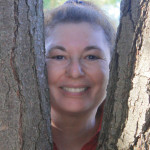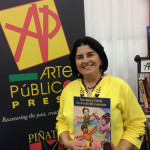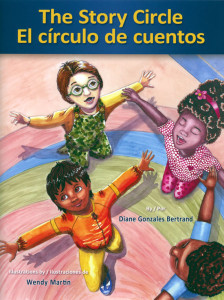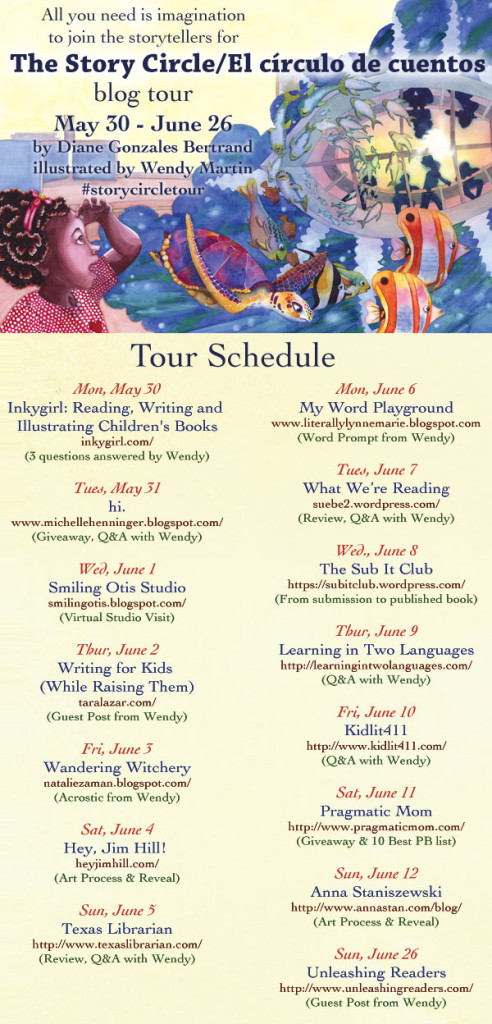Author Interview with Diane Gonzales Bertrand by Wendy Martin, Illustrator of The Story Circle
As an illustrator, I rarely if ever get to meet or interact with the authors of the books I illustrate. Sometimes, as is the case with this book, the publisher will introduce the writer and the artist after the book is finished. When I first was invited to illustrate “The Story Circle” I googled Diane. Unlike many of the other authors I know, she doesn’t have a large web presence, so she remained a bit of a mystery to me. After the book was published I was filled with curiosity about Diane’s experience as an educator and her school visits with our book. Below are her answers to my questions.
Wendy: How long have you been a teacher?
Diane: I have been an educator since 1980. I taught middle school, high school, and began teaching college in 1992. I have also taught writing workshops in libraries, schools, and community centers since my first book was published. Currently I am Writer-in-Residence for the English-Communications Studies Dept. at St. Mary’s University in San Antonio, Texas. I teach composition and creative writing to the next generation of readers and writers.
Wendy: How do you incorporate the books you write into the classroom?
Diane: Because my children’s books are written in two languages, teachers use the books in dual language classrooms and traditional classrooms to build vocabulary for emerging readers and to discuss literary elements for older children. For example The Empanadas that Abuela Made and The Party for Papa Luis are told in a sequence of repeating words. Not only do children learn vocabulary, they gain confidence in reading. My storybooks like Adelita and the Veggie Cousins or A Bean and Cheese Taco Birthday share positive messages about making friends and learning from someone who has a different opinion. They are useful in class discussions about ways to relate to others, but they also encourage children to write about their own experiences making new friends or celebrating their birthdays. When I come into a classroom, I rarely read my books; instead I show children ways to understand the writing process and explain how a book is created through my own revision process and through a collaborative effort with a talented illustrator. I encourage the children to become authors of their own stories. I also show them sketches and finished illustrations to encourage the young artists in the audience.
Wendy: How can teachers use the theme and idea behind The Story Circle in the class lesson plans?
Diane: When I have visited schools, children always ask me, “Where do you find ideas for stories?” I wanted to create a storybook for children to be given a sentence to start their story, then let their imagination take over. Some children have vivid imaginations and know how to grab an idea and start writing. Many more need a little help to start writing.
Teachers might introduce the book with “What If” scenarios. What if you knew how to fly? What if the science class had a field trip to the ocean? What if there was too much rain? Questions with no specific answers help children see possibilities. Writing isn’t a math equation with only one right answer, but a string of words that can change meaning and direction that is fun to explore. I love it best when writing goes in a direction I never expected. I want children to know this feeling as a positive thing, and not to worry about mistakes or writing something different than everyone else.
Wendy: You’ve mentioned that you utilize “story starters” during reading events. What are these and how do you use them?
Diane: ‘The Story Circle’ begins with damages after a terrible storm. The children return to school to discover flooding ruined their classroom, including the books on the bookshelves. The teacher uses the routine of their daily story circle to comfort the children, and after she tells them a story, each child decides to tell a story as well. I purposely present only the first sentence in each child’s story with the intention of providing “story starters” for children in the classroom to finish. I always encourage writing when I meet children; this book is a tangible way to keep children writing stories from their imaginations. Wendy Martin’s illustrations also provide wonderful details to complete the story and give an extra “starter” to the children with little confidence in their own ideas. Because technology distracts children from creating from their minds, I hope my words and Wendy’s pictures will brighten up a classroom with imaginative play.
Wendy: Would you care to share some of the reactions you’ve gotten during your recent book readings of The Story Circle?
Diane: I read The Story Circle in Houston, Texas, while the city was recovering from terrible flooding; so the children and their teachers could relate to the story well. As we reached each “story starter” sentence, I paused and asked children for ideas about what happened next. The children spoke about turning invisible if eating “magic candies” or that neighbors might peek through windows when Mrs. Martinez used goats instead of a lawnmower. One boy said an armadillo can roll into a ball, so it would win a race against the roadrunner, and another girl said a shark might come up to a glass-bottom boat, but the children begin yelling and scare it away. After my reading, when I was signing books for the school library, the teacher asked each child to come up to the front of the room and finish their favorite sentence/story from the book. I was reminded public speaking should also be encouraged in children, so this book supports that skill too.
Wendy: Before you saw my art for your story, did you have something in mind? How did my art differ from your imagination? Do you incorporate the book’s illustrations in your lesson plans?
Diane: After publishing a dozen books, I trust an illustrator as a talented artist who deserves respect for his or her own vision. When I saw sketches for The Story Circle, I was happy they were filled with details children might use to build a story of their own. Children who are talented in drawing (and I was not one of those children) can learn from studying the pictures to improve their own work. When I saw the first color illustrations, I felt pleased and couldn’t wait to share the book with readers. I didn’t have any preconceived images, but always hope for a good outcome. In the case of this book, it outshined my expectations.
About Wendy Martin: A transplanted New Yorker now living in Missouri, Wendy Martin has been working as an illustrator for 25+ years. Her love affair with art and illustration began at an early age. She never wanted to do anything else. So, she followed my heart and earned a degree in Fashion Design from the Fashion Institute of Technology, then continued my art education at the School of Visual Arts, earning a B.F.A. in Graphic Design. These disciplines can still be seen in her work as a children’s book illustrator and fantasy artist in the strong lines, textures and detailed patterns.
See additional art and find out more about her at wendymartinillustration.com
About Diane Gonzales Bertrand: Diane Gonzales Bertrand’s novels include ALICIA’S TREASURE (1995), TRINO’S CHOICE (1999), and TRINO’S TIME (2001) Her bilingual picture books include SIP, SLURP, SOUP, SOUP/CALDO, CALDO, CALDO (1997), FAMILY, FAMILIA (1999), THE LAST DOLL (2001), and UNCLE CHENTE’S PICNIC (2001). Her books are published by Arte Publico.
About The Story Circle: In this charming bilingual picture book, a group of young children revel in the joys of imagination to tell and illustrate stories.
Thank you to Wendy and Diane for your insightful interview about The Story Circle!
Don’t miss out on other stops on The Story Circle blog tour:





